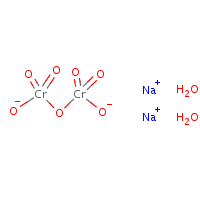Sodium dichromate dihydrate
Agent Name
Sodium dichromate dihydrate
CAS Number
7789-12-0
Formula
Cr2-O7.2Na.2H2-O
Major Category
Metals

Synonyms
Disodium dichromate dihydrate; Chromic acid (H2Cr2O7), disodium salt, dihydrate; Dichromic acid (H2Cr2O7), disodium salt, dihydrate; [ChemIDplus] Disodium oxido-(oxido-dioxo-chromio)oxy-dioxo-chromium hydrate; [ECHA - Annex XV Dossier] UN3086
Category
Chromium Compounds, Inorganic
Description
Reddish to bright orange solid; Somewhat deliquescent and soluble in water; [Merck Index] Orange-red odorless crystals; Hygroscopic and soluble in water; [Alfa Aesar MSDS]
Sources/Uses
Used as an oxidizing agent (to make dyes, inks, and other chemicals), bleaching agent (fats, oils, sponges, and resins), tanning agent, and mordant in dyeing; Also used in electric batteries, for refining petroleum, electro-engraving copper, in corrosion inhibitors and corrosion inhibiting paints, metal treatments, hardening gelatin, defoliation of cotton and other plants and shrubs, and as a topical anti-infective; [Merck Index] Used for metal finishing (chrome plating, electroplating, passivating, anodizing, and brightening), to make vitamin K, colored glass, ceramic glazes, essential oils, and perfumes; [ExPub: ECHA - Annex XV Dossier] Found as a contaminant in drinking water from industrial uses including electroplating, leather tanning, and textile manufacturing; [NTP]
Comments
An oxidizer that may cause fire on contact with combustible materials; Causes burns; May cause skin and respiratory sensitization; Toxic by ingestion; Highly toxic by inhalation; Harmful by skin absorption; [Alfa Aesar MSDS] See "Sodium dichromate." See "Chromium" and linked occupational diseases.
Biomedical References
Exposure Assessment
Skin Designation (ACGIH)
Yes
TLV (ACGIH)
0.0001 mg/m3, as Cr(VI), inhalable particulate matter
STEL (ACGIH)
0.0005 mg/m3, as Cr(VI), inhalable particulate matter
PEL (OSHA)
0.005 mg/m3, as Cr(VI)
Explanatory Notes
The Guide in the Emergency Response Guidebook is for "Toxic solid, oxidizing, n.o.s."
Adverse Effects
Skin Sensitizer
Yes
Asthma
Yes
Nephrotoxin
Yes
Dermatotoxin
Skin burns
IARC Carcinogen
Established
NTP Carcinogen
Human carcinogen
ACGIH Carcinogen
Confirmed Human
Diseases, Processes, and Activities Linked to This Agent
Diseases
Occupational diseases associated with exposure to this agent:
Processes
Industrial Processes with risk of exposure: